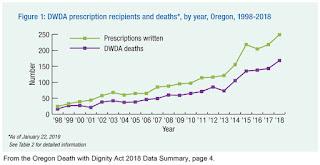Executive Director - Euthanasia Prevention Coalition
The 2018 Oregon annual assisted suicide report is similar to prior years. The report implies that the deaths were voluntary (self-administered), but the information in the report does not address that subject.
Order the pamphlet - Shedding light on assisted suicide in America.According to the 2018 Oregon assisted suicide report.
- There were 168 reported assisted suicide deaths up from 158 in 2017. When published, the 2017 report claimed that 143 people died by assisted suicide, 15 fewer than the actual number of death.
- 168 of 169 people who reportedly ingested lethal drugs in 2018, died from it, one person survived and died of natural causes.
- 11 of the deaths, the lethal drugs were prescribed in previous years.
- 3 of the patients were referred for a psychological or psychiatric evaluation.
- 2 physicians were referred to the Oregon Medical Board for failure to comply with the law.
- The time of death ranged from 9 minutes to 14 hours. When dying from DCMP2, death took on average 2 hours, with the longest time taking 21 hours.
- In 2018 one person died 807 days (more than 2 years and 2 months) after requesting assisted death.
- 43 people received lethal prescriptions, but their "ingestion" status is unknown.
- There were 249 lethal prescriptions obtained, up from 218 in 2017.
There may be more assisted suicide deaths.
According to the 2018 Oregon report, the ingestion status was unknown in 43 deaths. Last year the report stated that 143 people died by assisted suicide but then revised the report to state that 158 people died by assisted suicide.
When the ingestion status is unknown, it is possible that the person died by assisted suicide. Some or all of these deaths may represent unreported assisted deaths.
Oregon politicians debating expanding the eligibility criteria in the Oregon assisted suicide act.
Oregon House Bill HB 2232 proposes to change the definition of terminal from a six month prognosis to:
a disease that will, within reasonable medical judgment, produce or substantially contribute to a patient’s death.
Many people who are not "terminally" ill have a disease that will, within reasonable medical judgement, produce or substantially contribute to death. When considering the OHA inclusion of refusing medical treatment, this new definition enables wide-open assisted suicide.
Oregon Senate Bill SB 0579 enables a physician to wave the 15 waiting period when prescribing lethal drugs for suicide. The current Oregon assisted suicide law requires a 15 day waiting period. SB 0579 states:
Oregon Senate Bill SB 0579 enables a physician to wave the 15 waiting period when prescribing lethal drugs for suicide. The current Oregon assisted suicide law requires a 15 day waiting period. SB 0579 states:
Notwithstanding subsection (1) of this section, if the qualified patient’s attending physician has medically confirmed that the qualified patient will, within reasonable medical judgment, die before the expiration of at least one of the waiting periods described in subsection (1) of this section, the prescription for medication under ORS 127.800 to 127.897 may be written at any time following the later of the qualified patient’s written request or second oral request under ORS 127.840.
By waving the 15 day waiting period, a person can be approved for assisted suicide and die the next day.
Oregon Health authority has an expanded definition of terminal.
Stahle confirmed that the definition of terminal illness, used by the Oregon Health Authority includes people who may become terminally ill if they refuse effective medical treatment.
The responses to Stahle from the Oregon Health Authority also confirmed that there is no effective oversight of the Oregon assisted suicide law.
The yearly Oregon DWD reports are based on data from the physicians who prescribe and carry-out the assisted suicide death and the data is not independently verified. Therefore, we don't know if the information from these reports is accurate or if abuse of the law occurs.




No comments:
Post a Comment